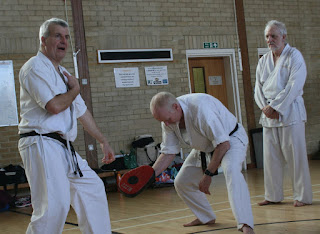The weekend retreat in Wales was the first for the Zenshin dojo 1st kyu (brown belt) group. After navigating enforced traffic delays, including the South Wales rush hour, accidents and roadworks, eventually eight members, drawn from across Zenshin dojo, sat together to enjoy excellent food prepared by Lucy. The idea of the retreat is to bring people together, allowing them to mix and
mingle in a way ordinarily difficult during the weekly practice schedule.
It doubles as an intensive karate experience and socially enjoyable get together. Lucy had pre-prepared an excellent chilli; one veggie, one meat, and all the trimmings. After supper, the group moved outside to the decking area adjacent to woodland and, in the cool evening air, drank, joked and conversed with each other whilst sitting comfortably around a blazing fire pit.
The next morning, after breakfast and posing for a pre
practice photo, the group drove the short distance to LLanstefan beach. The weather was amazing. The sun shone, the big sky was clear blue,
the rolling Welsh hills green and picturesque.
The otherwise deserted beach was a vast open space of golden sand
ranging from talc like softness to a yielding firmness.
Practice began immediately with a run to the water line and back before lining up for kihon. The
kihon practice, although simple and basic, enjoyed a magical quality. The group were encouraged to take advantage
of their spacious, open and glorious surroundings, keeping their vision up and
out as they moved slowly and methodically back and forth for a considerable
distance. The gang then adjourned to the
water’s edge where the group experienced kiba dachi and shiko dachi, rooting
themselves to the ground to prevent being blown over by the significantly
strong, warm wind racing across the water.
It was as if nature itself was testing their stances.
Later, the group worked their Heian katas and were
introduced to the conceptual “circle of excellence”, designed to encourage and
improve their understanding of mushin and zanshin. From Heian they progressed to Bassai Dai, the
traditional 1st kyu to 1st dan kata.
Much work needed to be done and the group separated into pairs, working
with each other, feeding back and discussing techniques.
 Lunch back at the Lodge was provided by Gemma and Bev; a
simple but delicious selection of salad, condiments, bread, quiche and cold
meats. Ninety minutes later everyone was
back on the beach, thrown head first into fast Sanbon, Ippon, jyu Ippon and jyu
kumite. It was a tough session, but the
time available allowed Rob to explain in detail the fundamentals of kumite, its
nuances and what was expected. The group
rose to the challenge and after much practice the intensity of engagement and
overall understanding grew to a more advanced level.
Lunch back at the Lodge was provided by Gemma and Bev; a
simple but delicious selection of salad, condiments, bread, quiche and cold
meats. Ninety minutes later everyone was
back on the beach, thrown head first into fast Sanbon, Ippon, jyu Ippon and jyu
kumite. It was a tough session, but the
time available allowed Rob to explain in detail the fundamentals of kumite, its
nuances and what was expected. The group
rose to the challenge and after much practice the intensity of engagement and
overall understanding grew to a more advanced level. After a short water break, it was the turn of Tekki drills
from the “clinch”. Unfamiliar for some
and a refresher for others. After
explaining these exercises were a form of kumite, but often interpreted as more
obvious self defence techniques, as opposed to the more profound skills and
qualities found in the previous kumite practice, Rob took the opportunity to
place Emily under considerable pressure by organising a mock “clinch”
assessment. Her seven assailants lined
up in front of her and attacked with right hooks as Emily defended herself with
vigour and searched for the presence of mind to deliver effective responses.
After a short water break, it was the turn of Tekki drills
from the “clinch”. Unfamiliar for some
and a refresher for others. After
explaining these exercises were a form of kumite, but often interpreted as more
obvious self defence techniques, as opposed to the more profound skills and
qualities found in the previous kumite practice, Rob took the opportunity to
place Emily under considerable pressure by organising a mock “clinch”
assessment. Her seven assailants lined
up in front of her and attacked with right hooks as Emily defended herself with
vigour and searched for the presence of mind to deliver effective responses.
As the clouds began to gather the group moved to the water’s
edge for final Bassai Dai practice.
First in groups, then solo, then finally in the cold, River Towy water.










































